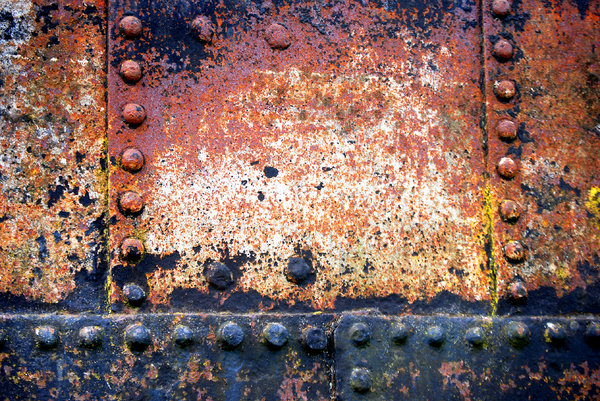 |
| Corrosion on the hull, or perhaps the skipper's breeches after an unnerving blow. |
It's an axiom of steel boat ownership and
Neil Young admiration that rust never sleeps. In fact, that's a reason people suggest is valid in rejecting steel and favouring fibreglass when choosing which material should best exemplify a voyaging sailboat's hull: Steel rusts and needs care and feeding in the form of chipping, grinding, zinc-coating and top-coating. Of course,
we've seen steel's resistance to puncture up close. A little brush-work seems a small price to pay.
The labour involved is, however, in fact true.
We knew it going in. Steel does require attention. It is also true, conversely, that if you are fairly fastidious and observant about such things, your steel boat will last many decades with only weekly or "as needed" sand-and-paint touch-ups that equal the equivalent area of, say, one's toenails.
If one
paints one's toenails, of course. I'm told crossing the Equator may involve
similar Neptunian revels.
Generally, however, there are
treatments and techniques, along with
observational habits, and a sense of the
most effective remediation techniques.
 |
| Still about the best, in my opinion, go-to guide for the likes of us. |
Now, I plan a rather more in-depth post on the whole "keep the steel intact" topic over the winter as I come to grips with the issues of
galvanic isolation,
anodes and the
question of bonding. Simply put, without a load of batteries aboard, a minimal charger, minimal draws and no actual connection between the prop and the (as yet unfired) engine, there's not a lot of reason (currently, pun intended) to worry about
Alchemy's hull at the moment. Trawling a piece of copper from one of a multimeter's test leads to the water and the other to the hull shows no appreciable voltage differential...
yet.
 |
| Steel boats and the true meaning of sacrifice. |
But things, as is their nature change, and I will report in more depth on this particular topic as I turn my continuing education into continual application. It does bring to the fore, in a typically circumloquacious fashion, the idea that as miniscule forces are forever at work at sea to undo first one's good intentions, and then one's expensive vessel, so are forces ashore creating change that may undo one's lubberly plans, or even one's seemingly ever-more-expensive property.
For us, such a force was wooden. elderly, tilted and fruit-bearing.
 |
| Still, alas, bearing fruit whilst creeping at 0.000001 knots on a SE heading. |
Behold our Very Large Cherry Tree. Approximately 60 feet tall and circa the age of the house (around 120 years...I have yet to count the rings or dig deep enough in the city property archives), this impressive specimen bore fruit, angry squirrels and nonchalant raccoons for the last 15 years, since we bought our place in downtown Toronto. And presumably did so for a century prior.
I suspected, given its rather close proximity to our house, that its too-close-for-comfort rootedness was probably the result of some VIctorian pip-spitting that missed the midden I found digging beneath the back door. I also suspected, despite the fact that we had already amputated a part of it ten years back in hopes of reducing its tendency to cant over our breakfasting room, that we might come to a day of reckoning with Very Large, but my wife adored its crookbacked stature, cock-eyed bearing and its ample shade. I felt less happy about its role in allowing raccoons and squirrels to frolic on our roof, but was, until the epic rains of last month, overruled.
 |
| From certain angles, it looked OK, despite a narrow space between eave and bough |
After
those rains, however, the very extensive roots started to heave up the concrete paving beside our house, along with the footpath to the neighbour's place next door. Action was required. Inspectors were summoned, and, having inspected, permits were issued with the words "immediate" and "emergency" in bold font.
Steps had to be taken, not only to deal with the seemingly increasing threat that the tree's sodden weight and gnarled roots would tear up the ground around, but with the possibility that, being ancient for a fruit tree, it might simply rot, blow down or otherwise fail worse than an America's Cup contender while we were off a-voyaging, and either take out a part of our house, the neighbour's garage (it was that tall), or even cause injury or loss of life.
Not to mention legal action. Nothing spoils a good sail like a lawsuit, I gather from my American friends.
 |
| A liability we could not afford, unfortunately. |
So down it had to come. While I would rather have spent the money on boaty things (and professional tree removal represented a significant chunk of change, as any visits by tradesmen to our particular postal code tend to be), we couldn't dodge this any more than could Helen Keller a falling tree. The crew that dispatched the cherry were rapid and professional and cleaned up after themselves, the polar opposite to many of my dealing with "marine experts", more is the pity. They certainly knew plenty of knots and hoisting methods. One tree-removing fellow had even sailed in the Antigua races. I would've chatted with him longer...but I was watching the ticking of the clock and was paying for each second.
 |
| The upstairs gets a radically broader southern exposure. |
We left a significant stump (below) for two reasons: One, my wife the biologist (not a
plant biologist, however) thinks that the cherry might resprout from such a tall stump, and it would take our entire lives and maybe our son's life before it would again pose a threat from toppling; two, if it doesn't resprout, that is one very large piece of log suitable for cutting for veneer. Not to raid the tomb, so to speak, but one in our situation is well-aware of the price of decorative trim and indeed any wood suitable for cabinetry. And
Alchemy's interior trim battens are already...you guessed it...cherry wood.
 |
| The pile of firewood behind this arborist is from the previous woody mutilation. |
We had leaves and branches hauled off, with limbs and trunk left in convenient 50-100 kilo chunks it amused me to watch the Cabin Boy attempt to move. Lots of chunks, some suitable for firewood, others for giant's Frisbees.
 |
| Some see sadness. I see about a hundred unique side table tops. |
It's now stacked for drying and, with luck, memorializing in the form of
binocular cases, folding table tops, and, if I can get my router skills
in order, a much-desired two-drawer map chest.
 |
| Like the bottom three drawers of this, but sized for Admiralty charts. I have a place already picked out in the pilothouse. |
And so a "house" thing and boat things may eventually overlap. Showing that necessary, if somewhat sad, maintenance of this sort needn't be all about destruction...we've saved not just the wood, but a handful of cherry pips from its final fruiting. And the breakfast room is now
ridiculously bright.
















No comments:
Post a Comment